DFI NF4 SLI-DR Expert – Can the best get better?
by Randi Sica on November 25, 2005 12:05 PM EST- Posted in
- Motherboards
Extreme Overclocking performance
As mentioned at the beginning of the review, we will now step away from the standard AnandTech review and present you with what many have asked to see with a board of this capability - Extreme overclocking results. In this phase, we’re not looking for the ultimate CPU top overclock, but rather how high we could push the FSB up on each CPU and remain 100% stable.
We’ll begin with the 4000+ San Diego aboard the Expert and 2x512MB OCZ PC4800EL dual channel Platinum Elite Limited Edition RAM modules at 2-3-3-8 1T with voltage bumped to 2.96V for stability at the tighter than advertised timings, at their rated speed at the 150 divider. Multiplier was reduced to keep the CPU at its rated CPU MHz.
This was the maximum stable and attainable FSB that the 4000+ San Diego was capable of performing.
We switched to the 3500+ Winchester to see what this board was made of. Previously on the original SLI-D, we could attain 500 MHz FSB, but only after booting at 425 MHz FSB and using ClockGen to climb up to the maximum stable FSB of 500 MHz. For this test, we installed the other part of the previously successful FSB test, 2x256MB G.Skill PC4400 LE RAM modules. To be quite honest, after using the 100 divider during this phase of testing, any of the BH-5 or TCCD modules that we had on hand would have worked just fine for these tests.
With the Expert, we went for the throat immediately and attempted a successful boot from the BIOS into Windows at 500 MHz FSB. This was a breeze to accomplish and stability was superb. LDT was set to auto, but showed in A64 Tweaker at 2.5, equating to a total LDT speed of 2500 MHz, which is just phenomenal. LDT voltage was set at 1.4V as well as Northbridhge voltage set at 1.96V.
A 16M SuperPi was run to assess stability before moving up the FSB ladder.
Our next step up saw us boot into Windows at 510 MHz FSB. This didn’t prove to be a stable FSB for running any benchmarks, but was a nice accomplishment nonetheless. The board with this CPU would not boot to Windows at any higher FSB speed at this point, so we used ClockGen to find the CPU’s limit, which ended up at 512 MHz FSB as illustrated earlier in the review. Again, a link to the CPU-Z verification can be found here.
The final phase was to determine the highest stable, benchmark-able FSB MHz that the CPU and board were capable of performing, which after much testing ended up being 505 MHz FSB. Runs of Aquamark3, 3Dmark 2003 and 2005, and a 32M SuperPi were run to confirm stability and repeatability.
Due to time constraints in compiling results for this review, top memory overclocking was not tested. We will do more testing with the 3500+ Winchester for a future review to see how far we can push the RMA modules in our arsenal. Previously with this CPU, we had reached 370 MHz 1:1 (2x256MB G.skill PC4400 LE) and it will be interesting to see how our newest modules can stack up to this CPU’s capability.
As mentioned at the beginning of the review, we will now step away from the standard AnandTech review and present you with what many have asked to see with a board of this capability - Extreme overclocking results. In this phase, we’re not looking for the ultimate CPU top overclock, but rather how high we could push the FSB up on each CPU and remain 100% stable.
We’ll begin with the 4000+ San Diego aboard the Expert and 2x512MB OCZ PC4800EL dual channel Platinum Elite Limited Edition RAM modules at 2-3-3-8 1T with voltage bumped to 2.96V for stability at the tighter than advertised timings, at their rated speed at the 150 divider. Multiplier was reduced to keep the CPU at its rated CPU MHz.
This was the maximum stable and attainable FSB that the 4000+ San Diego was capable of performing.
We switched to the 3500+ Winchester to see what this board was made of. Previously on the original SLI-D, we could attain 500 MHz FSB, but only after booting at 425 MHz FSB and using ClockGen to climb up to the maximum stable FSB of 500 MHz. For this test, we installed the other part of the previously successful FSB test, 2x256MB G.Skill PC4400 LE RAM modules. To be quite honest, after using the 100 divider during this phase of testing, any of the BH-5 or TCCD modules that we had on hand would have worked just fine for these tests.
With the Expert, we went for the throat immediately and attempted a successful boot from the BIOS into Windows at 500 MHz FSB. This was a breeze to accomplish and stability was superb. LDT was set to auto, but showed in A64 Tweaker at 2.5, equating to a total LDT speed of 2500 MHz, which is just phenomenal. LDT voltage was set at 1.4V as well as Northbridhge voltage set at 1.96V.
A 16M SuperPi was run to assess stability before moving up the FSB ladder.
Our next step up saw us boot into Windows at 510 MHz FSB. This didn’t prove to be a stable FSB for running any benchmarks, but was a nice accomplishment nonetheless. The board with this CPU would not boot to Windows at any higher FSB speed at this point, so we used ClockGen to find the CPU’s limit, which ended up at 512 MHz FSB as illustrated earlier in the review. Again, a link to the CPU-Z verification can be found here.
The final phase was to determine the highest stable, benchmark-able FSB MHz that the CPU and board were capable of performing, which after much testing ended up being 505 MHz FSB. Runs of Aquamark3, 3Dmark 2003 and 2005, and a 32M SuperPi were run to confirm stability and repeatability.
Due to time constraints in compiling results for this review, top memory overclocking was not tested. We will do more testing with the 3500+ Winchester for a future review to see how far we can push the RMA modules in our arsenal. Previously with this CPU, we had reached 370 MHz 1:1 (2x256MB G.skill PC4400 LE) and it will be interesting to see how our newest modules can stack up to this CPU’s capability.


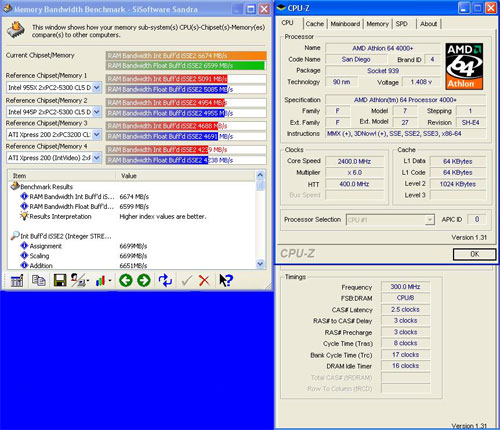
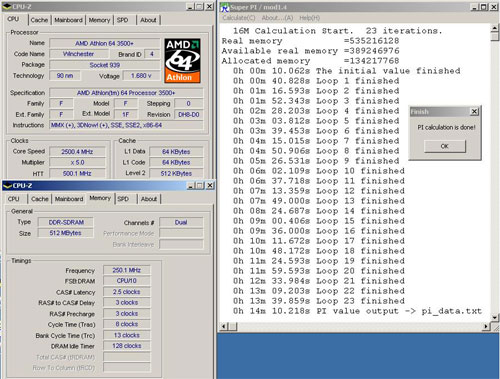
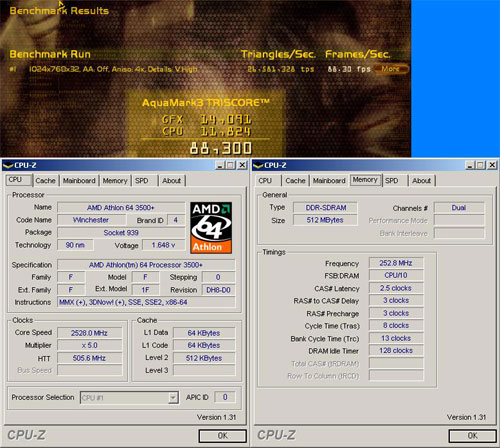
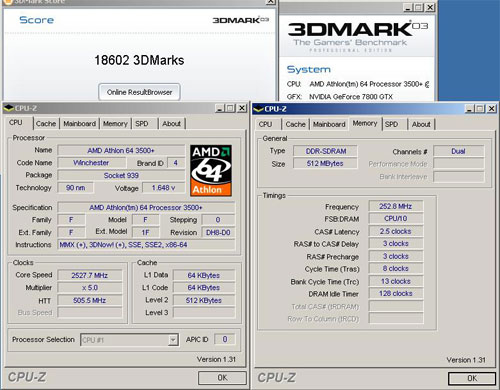
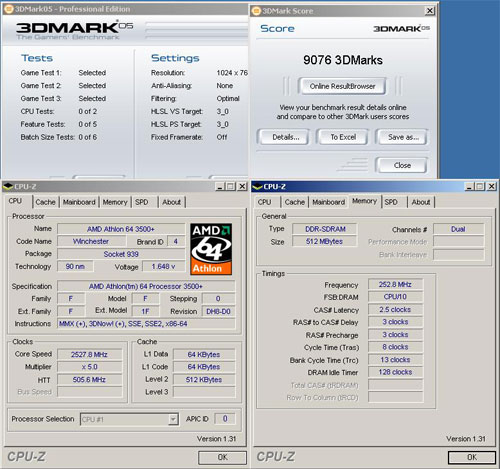
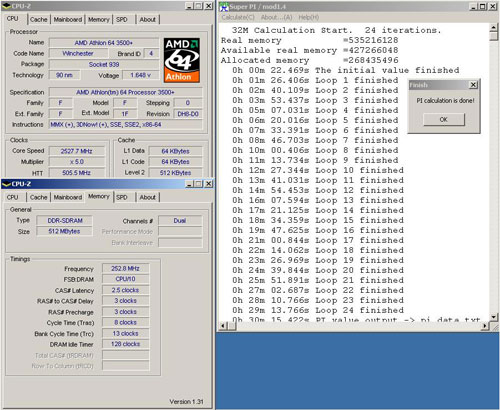








40 Comments
View All Comments
Wesley Fink - Friday, November 25, 2005 - link
The Expert uses the nForce4 chipset, so it supports SATA2 and NCQ. The performance of the nForce4 chipset is already well-documetned. THere are links on the first page to tests of all these nForce4 controllers and features.bob661 - Friday, November 25, 2005 - link
Nice board for the OCers. Too complicated for me.Zebo - Friday, November 25, 2005 - link
Besides being too expensive in this particular case.. everyone should looking into an overclocking "complicated" board simply because they are built to last overclocked! Which means they should last longer stock than cheezy boards even if you're not interested in tweaking at all. Notice he mentions highend componets on board like Jap caps..better cooling etc.ceefka - Friday, November 25, 2005 - link
I agree that good components and a stability are where it all begins.Still, for a price like this, I'd miss the features AT mentions and Firewire 800a
(on a PCIe lane, please). Plus I don't care for SLI. A simple 16x 4x 1x PCIe would do.
To me this an overture to what DFI can do. This one is a bit too much in the OC niche for me.
What would you consider a cheezy board? Just curious.
ceefka - Friday, November 25, 2005 - link
bummer, typo: 800a (?) forget the "a" please.Pete84 - Friday, November 25, 2005 - link
Wow, what an overclock!!bob661 - Friday, November 25, 2005 - link
Yeah. My jaw was dropped on that one. Never seen 500MHz on memory before. At least, not without extreme cooling.ViRGE - Friday, November 25, 2005 - link
The memory is not running at 500mhz, it was divided down to 250mhz. The 500mhz mark is purely a measure of the highest FSB that could be attained.NullSubroutine - Friday, November 25, 2005 - link
is this another penis test?Zebo - Friday, November 25, 2005 - link
Nice...Any word about a ultra expert? $200 way to much for a mobo if you don't need SLi. I can identify with heat on old ultra..mosfet HS get waaay too hot.. Another feature I like of this board is it looks like you might be able to replace fan with a passive Zalman thingi... old boards set chipset right under PCIe #1 leaving you no alternative but running a fan.